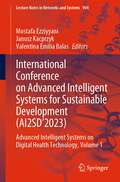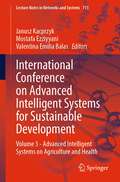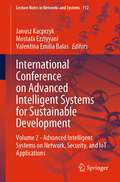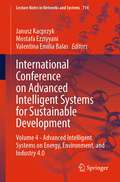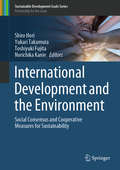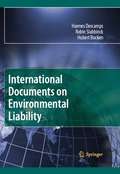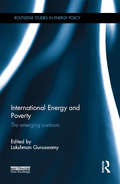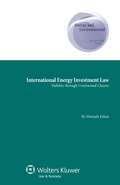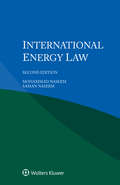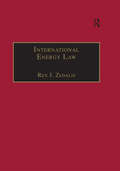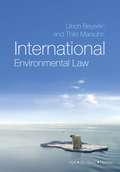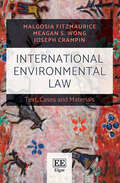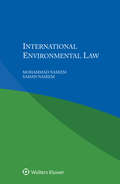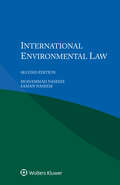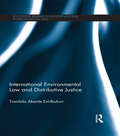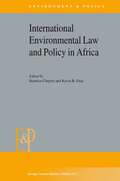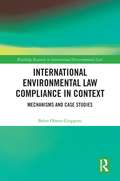- Table View
- List View
International Conference on Advanced Intelligent Systems for Sustainable Development: Advanced Intelligent Systems on Digital Health Technology, Volume 1 (Lecture Notes in Networks and Systems #904)
by Mostafa Ezziyyani Janusz Kacprzyk Valentina Emilia BalasThis book encapsulates the innovative discussions held during the International Conference on Advanced Intelligent Systems for Sustainable Development (AI2SD'2023), which took place at Mohammed 6 University of Sciences and Health Casablanca, Morocco. This book delves into the multifaceted realm of advanced intelligent systems, specifically focusing on digital health technology. The book offers a comprehensive exploration of cutting-edge research and breakthroughs in this dynamic field, providing a holistic perspective on the latest advancements. Within these pages, you will find papers covering an array of captivating topics, including AI-driven diagnostics, wearable health devices, predictive analytics in health care, and much more. Each contribution delves into the synergy of intelligent systems and digital health, showcasing how these technologies intertwine to shape the future of healthcare. Designed for researchers, practitioners, and enthusiasts alike, this book serves as an invaluable resource for staying updated on the latest trends and developments in the intersection of advanced intelligent systems and digital health technology. Whether you are seeking to broaden your knowledge or seeking practical insights, this book caters to a diverse readership eager to harness the potential of these innovative domains.
International Conference on Advanced Intelligent Systems for Sustainable Development: Volume 3 - Advanced Intelligent Systems on Agriculture and Health (Lecture Notes in Networks and Systems #713)
by Janusz Kacprzyk Mostafa Ezziyyani Valentina Emilia BalasThis book describes the potential contributions of emerging technologies in different fields as well as the opportunities and challenges related to the integration of these technologies in the socio-economic sector. In this book, many latest technologies are addressed, particularly in the fields of computer science and engineering. The expected scientific papers covered state-of-the-art technologies, theoretical concepts, standards, product implementation, ongoing research projects, and innovative applications of Sustainable Development. This new technology highlights, the guiding principle of innovation for harnessing frontier technologies and taking full profit from the current technological revolution to reduce gaps that hold back truly inclusive and sustainable development. The fundamental and specific topics are Big Data Analytics, Wireless sensors, IoT, Geospatial technology, Engineering and Mechanization, Modeling Tools, Risk analytics, and preventive systems.
International Conference on Advanced Intelligent Systems for Sustainable Development: Volume 2 - Advanced Intelligent Systems on Network, Security, and IoT Applications (Lecture Notes in Networks and Systems #712)
by Janusz Kacprzyk Mostafa Ezziyyani Valentina Emilia BalasThis book describes the potential contributions of emerging technologies in different fields as well as the opportunities and challenges related to the integration of these technologies in the socio-economic sector. In this book, many latest technologies are addressed, particularly in the fields of computer science and engineering. The expected scientific papers covered state-of-the-art technologies, theoretical concepts, standards, product implementation, ongoing research projects, and innovative applications of Sustainable Development. This new technology highlights, the guiding principle of innovation for harnessing frontier technologies and taking full profit from the current technological revolution to reduce gaps that hold back truly inclusive and sustainable development. The fundamental and specific topics are Big Data Analytics, Wireless sensors, IoT, Geospatial technology, Engineering and Mechanization, Modeling Tools, Risk analytics, and preventive systems.
International Conference on Advanced Intelligent Systems for Sustainable Development: Volume 1 - Advanced Intelligent Systems on Artificial Intelligence, Software, and Data Science (Lecture Notes in Networks and Systems #637)
by Janusz Kacprzyk Mostafa Ezziyyani Valentina Emilia BalasThis book describes the potential contributions of emerging technologies in different fields as well as the opportunities and challenges related to the integration of these technologies in the socio-economic sector. In this book, many latest technologies are addressed, particularly in the fields of computer science and engineering. The expected scientific papers covered state-of-the-art technologies, theoretical concepts, standards, product implementation, ongoing research projects, and innovative applications of Sustainable Development. This new technology highlights, the guiding principle of innovation for harnessing frontier technologies and taking full profit from the current technological revolution to reduce gaps that hold back truly inclusive and sustainable development. The fundamental and specific topics are Big Data Analytics, Wireless sensors, IoT, Geospatial technology, Engineering and Mechanization, Modeling Tools, Risk analytics, and preventive systems.
International Conference on Advanced Intelligent Systems for Sustainable Development: Volume 4 - Advanced Intelligent Systems on Energy, Environment, and Industry 4.0 (Lecture Notes in Networks and Systems #714)
by Janusz Kacprzyk Mostafa Ezziyyani Valentina Emilia BalasThis book describes the potential contributions of emerging technologies in different fields as well as the opportunities and challenges related to the integration of these technologies in the socio-economic sector. In this book, many latest technologies are addressed, particularly in the fields of computer science and engineering. The expected scientific papers covered state-of-the-art technologies, theoretical concepts, standards, product implementation, ongoing research projects, and innovative applications of Sustainable Development. This new technology highlights, the guiding principle of innovation for harnessing frontier technologies and taking full profit from the current technological revolution to reduce gaps that hold back truly inclusive and sustainable development. The fundamental and specific topics are Big Data Analytics, Wireless sensors, IoT, Geospatial technology, Engineering and Mechanization, Modeling Tools, Risk analytics, and preventive systems.
International Conflict over Water Resources in Himalayan Asia (Critical Studies of the Asia-Pacific)
by R. Wirsing C. Jasparro D. StollThe authors explore the fresh water crisis of Himalayan Asia. While the region hosts some of the world's mightiest rivers, it is also home to rapidly modernizing, increasingly affluent, and demographically multiplying societies, ensuring the rapid depletion of water resources and of disputes over ownership of transboundary waters.
International Development and the Environment: Social Consensus and Cooperative Measures for Sustainability (Sustainable Development Goals Series)
by Shiro Hori Yukari Takamura Toshiyuki Fujita Norichika KanieThis book analyzes the interplay between development and the environment, focusing on how to forge social consensus and practices in the international community. Since the Rio Earth Summit in 1992, sustainable development has increasingly attracted the attention of the international community, and several international agreements have been concluded to combat issues such as climate change. The Sustainable Development Goals (SDGs) were introduced as common objectives, and the Paris Agreement was adopted as a subsequent outcome. In light of today’s globalized world, how to best achieve sustainable development—and prioritize climate change in particular—is an issue involving various perspectives on the environment and economic development in the global community.The book provides students, businesspeople and government officials with a concept of sustainable development that is based on using social consensus, social norms, and practices (cooperative global actions) to achieve common goals. It is divided into three parts, the first of which focuses on the goals and development needed to achieve sustainable development. The second part explores measures to promote sustainable development, while the third highlights current climate change issues and aspects related to the effective implementation of international frameworks.
International Documents on Environmental Liability
by Hannes Descamps Robin Slabbinck Hubert BockenInternational Documents on Environmental Liability brings together 30 official full-text documents in the field of international environmental liability into an easily accessible, practical handbook; details the work of the International Law Commission on this topic; and provides the latest versions of international liability conventions and their statuses – including the latest on: (1) 2003 UNECE Kyiv Liability Protocol; (2) 2004 EC Directive on Environmental Liability; (3) 2005 Antartica Liability Annex. The authors’ combined capacity as an academic, policy advisor, and practitioner have helped bring forth a publication that reflects their experience of being involved in the development, negotiations and implementation of environmental liability regimes at both an international and European level.
International Energy and Poverty: The emerging contours (Routledge Studies in Energy Policy)
by Lakshman GuruswamyAround 2.8 billion people globally, also known as the "Other Third" or "energy poor", have little or no access to beneficial energy that meets their needs for cooking, heating, water, sanitation, illumination, transportation, or basic mechanical power. This book uniquely integrates the hitherto segmented and fragmented approaches to the challenge of access to energy. It provides theoretical, philosophical and practical analysis of energy for the low energy (non-hydrocarbon based) Other Third of the world, and how the unmet needs of the energy poor might be satisfied. It comprehensively addresses the range of issues relating to energy justice and energy access for all, including affordable - sustainable energy technologies (ASETs). The book breaks new ground by crafting a unified and cohesive framework for analysis and action that explains the factual and socio-political phenomenon of the energy poor, and demonstrates why clean energy is a primary determinant of their human progress. This is a must-read for all scholars, students, professionals and policy makers working on energy policy, poverty, and sustainable energy technologies.
International Energy and Poverty: The emerging contours (Routledge Studies in Energy Policy)
by Lakshman GuruswamyAround 2.8 billion people globally, also known as the "Other Third" or "energy poor", have little or no access to beneficial energy that meets their needs for cooking, heating, water, sanitation, illumination, transportation, or basic mechanical power. This book uniquely integrates the hitherto segmented and fragmented approaches to the challenge of access to energy. It provides theoretical, philosophical and practical analysis of energy for the low energy (non-hydrocarbon based) Other Third of the world, and how the unmet needs of the energy poor might be satisfied. It comprehensively addresses the range of issues relating to energy justice and energy access for all, including affordable - sustainable energy technologies (ASETs). The book breaks new ground by crafting a unified and cohesive framework for analysis and action that explains the factual and socio-political phenomenon of the energy poor, and demonstrates why clean energy is a primary determinant of their human progress. This is a must-read for all scholars, students, professionals and policy makers working on energy policy, poverty, and sustainable energy technologies.
International Energy Investment Law: Stability through Contractual Clauses
by Mustafa ErkanContemporary legal practice has developed powerful contractual mechanisms to mitigate the political risks attendant on energy projects. However, until now most of what we know about the contractual management of these risks has been based on theoretical literature and the facts of cases rather than careful empirical study. This one-of-a-kind book breaks new ground. The author presents the results of a questionnaire-based survey circulated to the main players in the petroleum sector, revealing actual existing contractual risk management techniques and showing a true picture of the political risk situation in the petroleum sector. Going far beyond an analysis of the literature, the research includes in-depth interviews with specialist lawyers and representatives of companies who have not only a theoretical knowledge but practical experience with the problems of host government interventions, as well as with international petroleum negotiators, members of international organizations in the petroleum business, and dispute settlement bodies.
International Energy Investment Law: Stability through Contractual Clauses
by Mustafa ErkanContemporary legal practice has developed powerful contractual mechanisms to mitigate the political risks attendant on energy projects. However, until now most of what we know about the contractual management of these risks has been based on theoretical literature and the facts of cases rather than careful empirical study. This one-of-a-kind book breaks new ground. The author presents the results of a questionnaire-based survey circulated to the main players in the petroleum sector, revealing actual existing contractual risk management techniques and showing a true picture of the political risk situation in the petroleum sector. Going far beyond an analysis of the literature, the research includes in-depth interviews with specialist lawyers and representatives of companies who have not only a theoretical knowledge but practical experience with the problems of host government interventions, as well as with international petroleum negotiators, members of international organizations in the petroleum business, and dispute settlement bodies.
International Energy Law
by Mohammad Naseem Saman NaseemDerived from the renowned multi-volume International Encyclopaedia of Laws, this book provides a systematic approach to legislation and legal practice concerning energy resources and production in International Energy Law. The book describes the administrative organization, regulatory framework, and relevant case law pertaining to the development, application, and use of such forms of energy as electricity, gas, petroleum, and coal, with attention as needed to the pervasive legal effects of competition law, environmental law, and tax law. A general introduction covers the geography of energy resources, sources and basic principles of energy law, and the relevant governmental institutions. Then follows a detailed description of specific legislation and regulation affecting such factors as documentation, undertakings, facilities, storage, pricing, procurement and sales, transportation, transmission, distribution, and supply of each form of energy. Case law, intergovernmental cooperation agreements, and interactions with environmental, tax, and competition law are explained. Its succinct yet scholarly nature, as well as the practical quality of the information it provides, make this book a valuable resource for energy sector policymakers and energy firm counsel handling cases affecting International Energy Law. It will also be welcomed by researchers and academics for its contribution to the study of a complex field that today stands at the foreground of comparative law.
International Energy Law: Rules Governing Future Exploration, Exploitation and Use of Renewable Resources
by Rex J. ZedalisThe international legal rules affecting renewable alternative energy resources are amongst the most important legal and environmental concerns of the near future. As traditional energy sources are depleted, new technologies are being developed to harness the potentials of wave, current and tidal energy, coastal wind power, offshore geothermal, polar energy resources and space-based solar collection. This book is the first comprehensive analysis of the legal rules governing the alternative energy resource potential of all international common areas - the high seas, the polar zones (especially Antarctica) and outer space. In a detailed, but precisely analyzed text, the book also reviews the international environmental rules affecting exploration, exploitation and use of internationally situated energy resources, alongside resources located offshore under national jurisdictions. This is accompanied by a critical look at the connection between efforts to control greenhouse gases and the growing interest in non-polluting alternatives found in the international "commons . The result is a work of unprecedented value for environmental and international law academics and practitioners, as well as those interested in environmental resource economics and politics.
International Energy Law: Rules Governing Future Exploration, Exploitation and Use of Renewable Resources
by Rex J. ZedalisThe international legal rules affecting renewable alternative energy resources are amongst the most important legal and environmental concerns of the near future. As traditional energy sources are depleted, new technologies are being developed to harness the potentials of wave, current and tidal energy, coastal wind power, offshore geothermal, polar energy resources and space-based solar collection. This book is the first comprehensive analysis of the legal rules governing the alternative energy resource potential of all international common areas - the high seas, the polar zones (especially Antarctica) and outer space. In a detailed, but precisely analyzed text, the book also reviews the international environmental rules affecting exploration, exploitation and use of internationally situated energy resources, alongside resources located offshore under national jurisdictions. This is accompanied by a critical look at the connection between efforts to control greenhouse gases and the growing interest in non-polluting alternatives found in the international "commons . The result is a work of unprecedented value for environmental and international law academics and practitioners, as well as those interested in environmental resource economics and politics.
International Environmental Governance
by Peter M. HaasInternational Environmental Governance reviews the contentious approaches to addressing global and transboundary environmental threats. The volume collects together the most influential and important literature on the major political approaches to dealing with these problems, their histories, major debates, and research frontiers. It is accompanied by a substantial introduction which reviews the evolution of the academic contribution to environmental governance, focusing on a wide array of international environmental problems.
International Environmental Governance
by PeterM. HaasInternational Environmental Governance reviews the contentious approaches to addressing global and transboundary environmental threats. The volume collects together the most influential and important literature on the major political approaches to dealing with these problems, their histories, major debates, and research frontiers. It is accompanied by a substantial introduction which reviews the evolution of the academic contribution to environmental governance, focusing on a wide array of international environmental problems.
International Environmental Law
by Ulrich Beyerlin Thilo MarauhnInternational Environmental Law is a new textbook written for students, practitioners, and anyone interested in the subject. The overall aim of the book is to provide a fresh understanding of international environmental law as a whole, seen in the light of climate change, biodiversity loss, and the other serious environmental challenges facing the world. The book has also been kept deliberately manageable in size by careful selection of topics and by adopting a cross-cutting synthesis of regulatory interaction in the field. This enables the reader to place international environmental law in the broader context of public international law in general, revealing at the same time that international environmental law is experimental ground for developing new legal approaches towards global governance. To this end, the authors have combined theory and practice.Apart from discussing concepts, rule-making and compliance, the book looks at options for improved coordination, harmonisation and even integration of existing multilateral environmental agreements, analysing how conflicts between various environmental regimes can be avoided or, at least, adequately managed. The authors argue that an appropriate management of international environmental relations must address the North-South divide, which continues to be a major obstacle to global environmental cooperation. Furthermore, the authors emphasise the growing human rights dimension of international environmental law.This book is an ideal 'door opener' for the further study of international environmental law. Focusing on 'international environmental governance' in a comprehensive way, it serves to explain that each institution, each actor, and each instrument is part of a multi-dimensional process in international environmental law and relations.
International Environmental Law: Text, Cases and Materials
by Malgosia Fitzmaurice Meagan S. Wong Joseph CrampinThis textbook provides a compelling and structured introduction to international environmental law in the Text, Cases and Materials genre.The book uses extracts from a judiciously selected range of legal instruments and case law relevant to the protection and regulation of the environment in international law, alongside commentary from the author team and questions for class discussion, to facilitate student understanding and encourage engagement in the topic.Divided into four main parts, it examines the main principles of international environmental law, the key areas of substantive environmental regulation, the implementation of environmental law and the relations between environmental law and other areas of international law. Key Features: Provides concise introductions to each topic of environmental lawDiscussion questions and further reading sections guide students in applying their understandingFamiliarises students with the key legal materials, treaties and case law relating to international environmental lawCovers a wide variety of topics, including sustainable development, protection of the marine environment, atmospheric protection and responsibility and liability for environmental damage By introducing and highlighting the most important instruments and cases of international environmental law, this textbook seeks to provide environmental law students and non-specialists with a rich and full understanding of the topic.
International Environmental Law
by Mohammad Naseem Saman NaseemDerived from the renowned multi-volume International Encyclopaedia of Laws, this book provides ready access to treaties,conventions, legislation and practice concerning the International Environmental Law. A general introduction covers geographic considerations, political, social and cultural aspects of environmental study, the history, sources and principles of environmental law, environmental legislation, carbon credits and the role of public authorities. The main body of the book deals first with laws aimed directly at protecting the environment from pollution in specific areas such as air, water, waste, soil, noise, and radiation. Then, a section on nature and conservation management covers protection of natural and cultural resources such as monuments, landscapes, parks and reserves, wildlife, agriculture, forests, fish, subsoil, and minerals. Further treatment includes the application of zoning and land-use planning, rules on liability, and administrative and judicial remedies to environmental issues and disputes. There is also an analysis of the impact of international and regional legislation and treaties on environmental regulation. Its succinct yet scholarly nature, as well as the practical quality of the information it provides, make this book a valuable resource for lawyers handling cases dealing with and affecting international environment. Academics and researchers, as well as business investors,corporate houses and international organizations in the field, will welcome this very useful guide, and will appreciate its value in the study of comparative international environmental law and policy.
International Environmental Law
by Mohammad Naseem Saman NaseemDerived from the renowned multi-volume International Encyclopaedia of Laws, this book provides ready access to treaties, conventions, legislation and practice concerning the International Environmental Law. A general introduction covers geographic considerations, political, social and cultural aspects of environmental study, the history, sources and principles of environmental law, environmental legislation, carbon credits and the role of public authorities. The main body of the book deals first with laws aimed directly at protecting the environment from pollution in specific areas such as air, water, waste, soil, noise, and radiation. Then, a section on nature and conservation management covers protection of natural and cultural resources such as monuments, landscapes, parks and reserves, wildlife, agriculture, forests, fish, subsoil, and minerals. Further treatment includes the application of zoning and land-use planning, rules on liability, and administrative and judicial remedies to environmental issues and disputes. There is also an analysis of the impact of international and regional legislation and treaties on environmental regulation. Its succinct yet scholarly nature, as well as the practical quality of the information it provides, make this book a valuable resource for lawyers handling cases dealing with and affecting international environment. Academics and researchers, as well as business investors, corporate houses and international organizations in the field, will welcome this very useful guide, and will appreciate its value in the study of comparative international environmental law and policy.
International Environmental Law and Distributive Justice: The Equitable Distribution of CDM Projects under the Kyoto Protocol (Routledge Research in International Environmental Law)
by Tomilola Akanle Eni-IbukunThe Clean Development Mechanism (CDM) is widely regarded as one of the Kyoto Protocol’s best creations and as an essential part of the international climate change regime. The CDM has been constantly evolving to ensure that it fulfils its objectives of mitigating climate change and contributing to sustainable development in developing countries. The over 6,000 registered projects under the CDM are estimated to have generated almost US$200 billion of investment in developing countries and are expected to achieve GHG emission reductions of about 6.8 billion tonnes. Nevertheless, the CDM is not perfect, and one of its main problems is the inequitable geographic distribution of projects among developing countries. Understandably, this is a problem that countries are very keen to address, and since 2001, even before the first project was registered, countries have been highlighting the need to ensure that projects are equitably distributed among participating countries. This book looks at distributive justice under the CDM regime and focuses on the issue of equity in the geographic distribution of CDM projects among developing countries. The book investigates relevant aspects of international law to identify the legal characteristics of equitable distribution or distributive justice, in order to establish what equitable distribution in the CDM should look like. Based on these investigations, Tomilola Akanle Eni-Ibukun breaks new ground in defining equitable distribution under the CDM and exploring how key obstructions to the equitable distribution of projects may be overcome. The book will be of particular interest to academics and policymakers of climate change and the CDM within international law.
International Environmental Law and Distributive Justice: The Equitable Distribution of CDM Projects under the Kyoto Protocol (Routledge Research in International Environmental Law)
by Tomilola Akanle Eni-IbukunThe Clean Development Mechanism (CDM) is widely regarded as one of the Kyoto Protocol’s best creations and as an essential part of the international climate change regime. The CDM has been constantly evolving to ensure that it fulfils its objectives of mitigating climate change and contributing to sustainable development in developing countries. The over 6,000 registered projects under the CDM are estimated to have generated almost US$200 billion of investment in developing countries and are expected to achieve GHG emission reductions of about 6.8 billion tonnes. Nevertheless, the CDM is not perfect, and one of its main problems is the inequitable geographic distribution of projects among developing countries. Understandably, this is a problem that countries are very keen to address, and since 2001, even before the first project was registered, countries have been highlighting the need to ensure that projects are equitably distributed among participating countries. This book looks at distributive justice under the CDM regime and focuses on the issue of equity in the geographic distribution of CDM projects among developing countries. The book investigates relevant aspects of international law to identify the legal characteristics of equitable distribution or distributive justice, in order to establish what equitable distribution in the CDM should look like. Based on these investigations, Tomilola Akanle Eni-Ibukun breaks new ground in defining equitable distribution under the CDM and exploring how key obstructions to the equitable distribution of projects may be overcome. The book will be of particular interest to academics and policymakers of climate change and the CDM within international law.
International Environmental Law and Policy in Africa (Environment & Policy #36)
by B. Chaytor K. R. GrayC.O.OKIDl1 I welcome the opportunity to prepare a Foreword to the book on Environmental Policy and Law in Africa, edited by Kevin R. Gray and Beatrice Chaytor. It is a pleasure to do that because the book is a contribution to the cause of capacity building for development and implementation of environmental law in Africa, a goal towards which I have had an undivided focus over the last two decades. There is still some belief in and outside Africa that for developing countries in general, and Africa in particular, development and implementation of environmental law is not a priority. This belief prevails strongly in many quarters of the industrialised countries. In fact, the view is held either out of blatant ignorance or by some renegade industrialists who fail to appreciate Michael Royston's 1979 thesis that Pollution Prevention Pays.2 That group, for obvious reasons, must have their correspondent counterparts in Africa to provide hope that industries rejected as derelict in the West or inoperable due to rigorous environmental regulation, can find homes to which they can escape and dump their polluting industries.
International Environmental Law Compliance in Context: Mechanisms and Case Studies (Routledge Research in International Environmental Law)
by Belen Olmos GiupponiThis book explores how compliance with international environmental law has changed over time, offering a critical analysis of its current shifting patterns. Beginning with an overview of compliance with international environmental law, the book goes on to explore in detail: compliance in the different legal regimes instituted by Multilateral Environmental Agreements (MEAs), the addition of new subjects of international law, the legal relations between developed and developing countries, and the emergence of new compliance mechanisms in global environmental law. The analysis takes two key developments into consideration: the evolution in forms of compliance and non-state involvement in compliance with international environmental law. In the final section, three case studies are provided to demonstrate how these changes have occurred in selected areas: climate change, biodiversity and water resources. Throughout the book, topics are illustrated with extracts from specific international environmental law jurisprudence and relevant international environmental law instruments. In doing so, the book offers a comprehensive analysis of compliance with international environmental law, providing original insights and following a clear and systematic structure supported by reference to the sources. This book will be of interest to professionals, academics and students working in the field of compliance with international environmental law.
